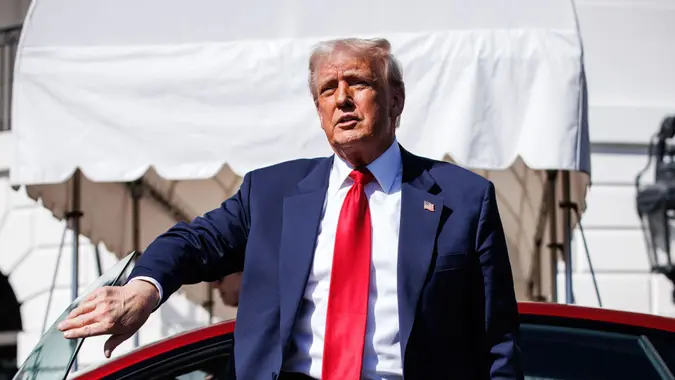Here’s How Much the Price of a New Car Has Changed Since the Beginning of Trump’s First Term in 2017

Commitment to Our Readers
GOBankingRates' editorial team is committed to bringing you unbiased reviews and information. We use data-driven methodologies to evaluate financial products and services - our reviews and ratings are not influenced by advertisers. You can read more about our editorial guidelines and our products and services review methodology.

20 Years
Helping You Live Richer

Reviewed
by Experts

Trusted by
Millions of Readers
One thing’s for certain: If you’re in the market to buy a new car, prepare for some degree of sticker shock — particularly if the last time you bought a new vehicle was nearly a decade ago.
According to a comparison of two Kelley Blue Book reports, one published following President Donald Trump’s first inauguration in 2017 and a second published Mar. 11, the average price for a new vehicle has risen by about $13,000.
Data speaks to prices as of January 2017 and February 2025, respectively, and notably, that cost increase of approximately 37% outpaces the general rate of cumulative inflation, which ranges from 29.9% to 31.41%.
Average New Vehicle in 2017 vs. 2025
The data indicated that, if you were to pick up a brand new ride in early 2017, the MSRP attached would rest at an average of $34,986, all classes, makes and models considered. For early 2025, that figure increased to $48,039.
Some category breakdowns are presented below:
- Compact car: $20,610 in 2017 vs. $26,882 in 2025.
- Full-size car: $34,286 in 2017 vs. $38,272 in 2025.
- Full-size pickup truck: $47,035 in 2017 vs. $63,578 in 2025.
- Mid-size SUV/crossover: $37,370 in 2017 vs. $48,403 in 2025.
- Luxury car: $56,202 in 2017 vs. $57,194 in 2025.
- Minivan: $33,590 in 2017 vs. $48,086 in 2025.
- Sports car: $30,665 in 2017 vs. $48,341 in 2025.
The one standout appears to be the luxury car category. Across all other categories, significant inflationary effects have been felt, perhaps exacerbated by the supply chain issues and other macroeconomic forces that caused vehicle prices to skyrocket during 2020 and throughout the pandemic years, as CarBuzz outlined.
Trump Tariffs Could Cause Second Wave of Car Price Increases
Soaring price tags attached to new vehicles sitting in showrooms may not be slowing in the immediate future, either.
According to a Mar. 3 report from BNN Bloomberg, the price attached to a new car, truck, or SUV could tick upward by as much as $12,000 if the tariffs instituted by President Trump continue, or intensify. With industry analysts offering a wide variety of prognostications — including slowed demand for pricier models, a $4,000 increase in the price to manufacture the average crossover SUV, and some models being removed from sale entirely — some onlookers hope for a timelier resolution.
“The expectation is that — at worst — they’re [the tariffs] around for a couple months and, at best, they keep getting pushed” off, said Dan Hearsch, leader of the Americas automotive practice at consultant AlixPartners.
“Those are not intended as trade actions. Those are border security negotiations.”
Data from 2013dollars and SmartAsset.
 Written by
Written by  Edited by
Edited by 

























